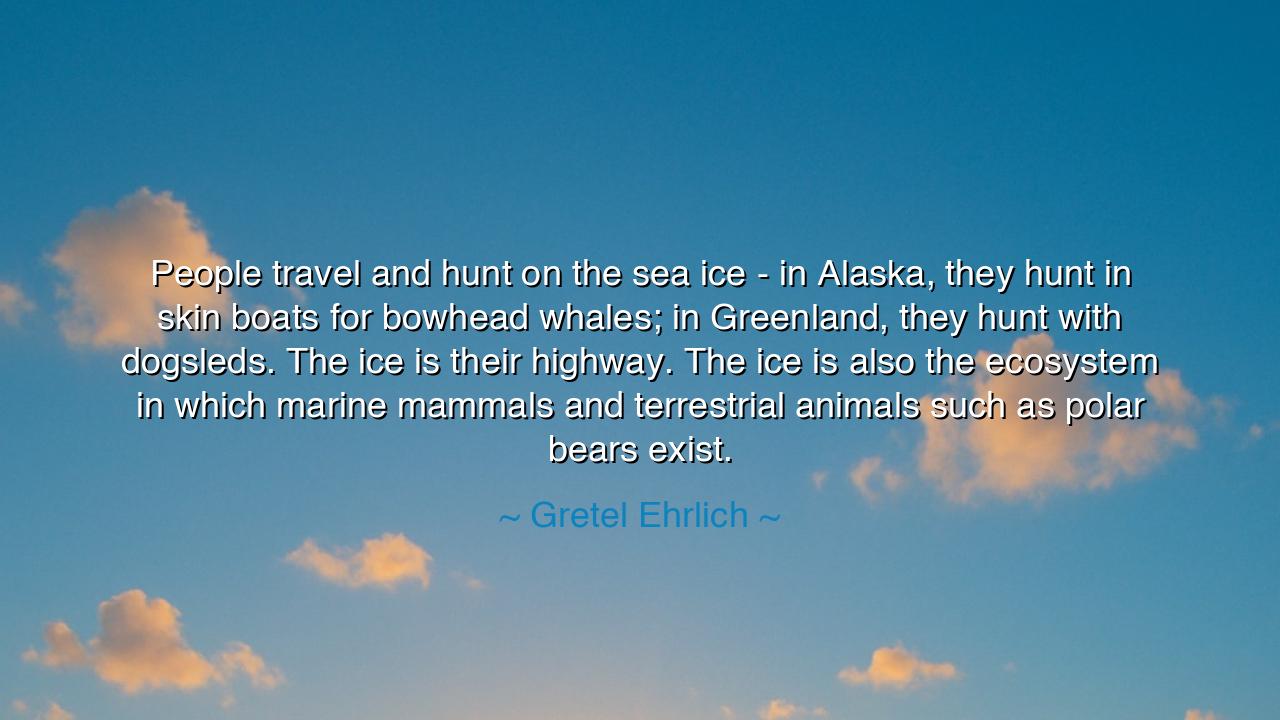
People travel and hunt on the sea ice - in Alaska, they hunt in
People travel and hunt on the sea ice - in Alaska, they hunt in skin boats for bowhead whales; in Greenland, they hunt with dogsleds. The ice is their highway. The ice is also the ecosystem in which marine mammals and terrestrial animals such as polar bears exist.






In the words of Gretel Ehrlich, poet of wilderness and witness of the Arctic, we hear a truth carved in ice: “People travel and hunt on the sea ice—in Alaska, they hunt in skin boats for bowhead whales; in Greenland, they hunt with dogsleds. The ice is their highway. The ice is also the ecosystem in which marine mammals and terrestrial animals such as polar bears exist.” These words are not only description but revelation: they remind us that for those who dwell in the far North, ice is not emptiness, but life itself, both road and home, both sustainer and destroyer.
To call the ice a highway is to honor its role as the bridge that binds lives and communities. Where others see only desolation, the Inuit, the Yupik, and the Greenlanders see a path across the world. They follow the grooves of the ice as others follow roads, traveling to hunt, to visit, to survive. The ice bears their sleds, their footsteps, their songs. It is the white thread stitching together a land that otherwise seems broken by sea. Without it, there would be no passage, no way of life.
And yet, the ice is also the ecosystem—not merely a surface to move upon, but a cradle of life. Beneath it swim the bowhead whales, massive creatures that nourish the hunters who pursue them with skill and reverence. Upon it walk the polar bears, kings of the frozen lands, whose strength depends on the vast expanse of ice to hunt their prey. Seals, walruses, foxes—all live by its rhythms. Thus, the ice is both ground and sky, both foundation and lifeblood, the stage on which life itself is performed in the Arctic.
History offers us vivid examples of this truth. When explorers from the South—men like Fridtjof Nansen—ventured into the Arctic, they marveled that people could not only survive but thrive there. They saw hunters in skin boats, gliding silently across the cracks in the sea ice in pursuit of whales, using knowledge passed down for generations. They saw teams of dogs, their breath rising like smoke in the air, pulling sleds across the frozen miles with unmatched speed and endurance. These acts were not mere survival, but a harmony between human culture and the ice, each respecting the other.
Ehrlich’s words also carry a warning hidden in their reverence. For the ice, which has endured for millennia, is now retreating under the heat of global warming. If the ice is the highway, then the highway is crumbling; if the ice is the ecosystem, then the foundation of countless lives is dissolving. What she describes with awe is also fragile, endangered by forces unleashed far from the Arctic itself. The hunters, the animals, the very rhythm of life on the ice tremble as their stage disappears.
But her vision is not despair alone—it is also instruction. She teaches us that to look at ice is not to see nothingness, but everything: a web of lives intertwined, human and animal, ancient and modern. The hunter with his skin boat or dogsled is not primitive, but wise—his knowledge of the ice is a form of genius, learned through patience and humility. The animals that depend on the ice remind us that our fate is tied to theirs, for when their world cracks, so does our own.
The lesson is clear: see the world not as empty, but as full of meaning. What seems barren may be a highway; what seems cold may be the womb of life. Respect the systems—whether ice, forest, or desert—that sustain both man and beast. And above all, guard them against destruction, for their loss is our loss.
So I say to you: walk with reverence when you look upon the ice. Remember the hunters in Alaska and Greenland, the whales beneath, the polar bears above. Let their world awaken you to the truth that the earth is alive, intricate, and sacred. Protect it, for to destroy it is to unravel the highway of life itself, and to silence the voices of generations who have called it home.






AAdministratorAdministrator
Welcome, honored guests. Please leave a comment, we will respond soon